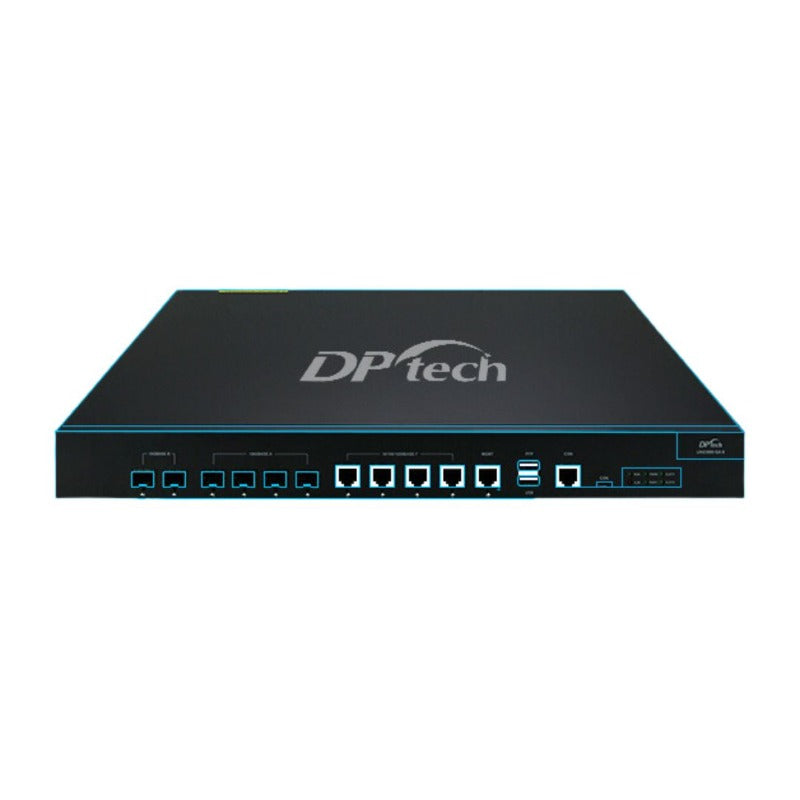Are you a reseller? Log in to get your reseller discount. Discount is reflected in the cart.
Are you a reseller? Log in to get your reseller discount. Discount is reflected in the cart.
Are you a reseller? Log in to get your reseller discount. Discount is reflected in the cart.
Are you a reseller? Log in to get your reseller discount. Discount is reflected in the cart.
DPtech
Unified Audit Gateway
Unified Audit Gateway
SKU: Part Number:
Out of stock
Price available upon request
Description & specifications
A large amount of application traffic transmitted on the network will lead to congestion at the network egress, and potential hazards such as failure to monitor the working status, leakage of sensitive information, even legal violations. The UAG3000, or Unified Audit Gateway (UAG), an independently developed product from DPtech is designed to provides users with professional application control, bandwidth management, Internet behavior auditing, keyword filtering, and user behavior analysis. It helps users make rational utilization of network bandwidth, ensure data security, improve working efficiency, and avoid legal risks, enabling a visible, controllable and optimizable network for users.
- Massive features to ensure precise control
Identifying more than 5,200 network layer and application layer protocols, it allows customized network applications based on features and enables precise Internet behavior management and traffic control in IPv4/IPv6 environments.
- Flexible authentication and real-name auditing
Authentication methods include third-party authentication such as user/MAC/IP, Portal local, Radius, and LDAP, SMS authentication, WeChat authentication, and transparent authentication. By integrating with mainstream systems like Srun Software and Dr.COM, it acquires correspondence relationship between users and IP addresses, enabling user-specific unified auditing, satisfying the requirements for security compliance in accordance with Provisions on Technical Measures for Internet Security Protection (Order No. 82 of the Ministry of Public Security), the Regulations on Internet Security Supervision and Inspection by Public Security Organs (Order No. 151 of the Ministry of Public Security), and the Regulations on network security Multi-level Protection Scheme.
- Visible networking quality
User’s bandwidth utilization can be presented through multiple metrics, such as user, application, traffic, and time. Besides, networking quality is analyzed to monitor network delay, status code, retransmission rate and other parameters, providing an overall understanding of user, application and Web access.
- Link Load Balancing
Featuring network segment table of mainstream domestic carriers, it can hold sessions and perform health check. Available scheduling algorithms include polling, minimum bandwidth utilization, source-destination address hashing, minimum connection, etc, thereby enabling carrier traffic scheduling, overload traffic scheduling, customized traffic scheduling based on four-layer ports, and other scheduling policies. Moreover, it can be used as a link optimization gateway and support gateway mode, NAT, routing and forwarding.
- Perfect local logs
Local hard disk storage is enabled, which help make the best of users’ IT infrastructure investment without the need of installing a data storage server. It provides analysis reports on traffic trends from the perspectives of interfaces, users, applications and time, allowing users to investigate into users or applications with a large bandwidth consumption on the network. It can make statistics of users’ behavior by calculating their time spent on non-work related applications, such as games, videos, and shopping. It keeps a record of users’ online behaviors, including detailed information on Web access, email transmission, instant messaging, and forum access.
| Product Functions | Function Descriptions |
|---|---|
| Networking modes | Transparent mode, bridge mode, bypass mode, gateway mode |
| Network Features | It supports routing protocols such as IPv4/v6, RIP, OSPF, ISIS, BGP, static routing and policy-go-together. |
| Service identification | Supporting more than 5,200 mainstream network layer and application layer protocols, it enables precise Internet behavior management and traffic control. |
| Custom applications | It supports custom web applications based on deep detection (with application features). |
| Application control | It allows to limit the access speed of or block access to P2P, IPTV, games, instant messaging and other applications. |
| Multi-dimensional authorization | Internet access can be granted based on user/user group, IP/IP group, time periods, and application protocols. |
| URL filtering | Equipped with a URL address library consisting of ten million entries, it supports URL classification filtering, URL advanced filtering and URL redirection. |
| Keyword filtering | Keyword filtering is realized on emails, forums, web page searches, web browsing and HTTP POST. |
| Behavior Auditing | It can perform content auditing on Web applications, Web searches, emails, forums, instant messaging, and FTP. |
| Access authentication | A series of authentication methods can be enabled based on IP/MAC binding, Portal, SMS, WeChat and so on .Integrating with authentication methods of local, Radius, LDAP, PPPoe, and domain monitoring, and mainstream systems like Shenlan Software and Dr.COM, it gathers information on user/IP correspondence. |
| Bandwidth management | Bandwidth limits and guarantees |
| NAT | Support source NAT, destination NAT, one-to-one NAT, NAT address pool and other NAT functions. |
| Network quality analysis | Monitor network delay, status code, retransmission rate and other parameters, providing an overall understanding of user, application and Web access |
| Link Load Balancing | Available scheduling algorithms include polling, minimum bandwidth utilization, source-destination address hashing, minimum connection, etc. |
| Antivirus protection | Three levels of Antivirus protection are enabled, through which users can configure different levels of Antivirus protection based on the popularity of viruses. |
| High Reliability | Silent dual system, dual-system hot standby, VRRP multi-master and other modes are supported.Power fail safeguard is enabled for embedded electrical interfaces. |
| Different permissionsbased on division andclassification | Users are assigned with different management permissions based on customized division and classification, thereby classifying user groups and application protocols per permissions. |


